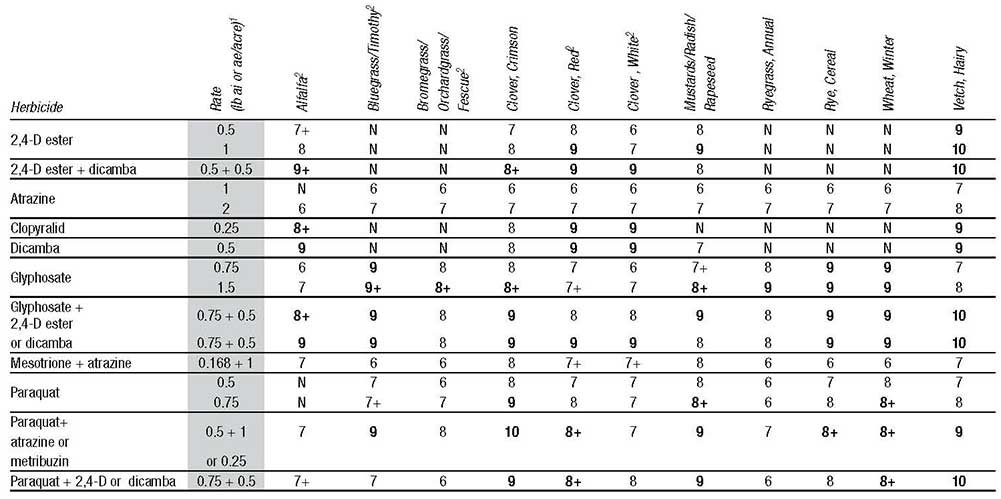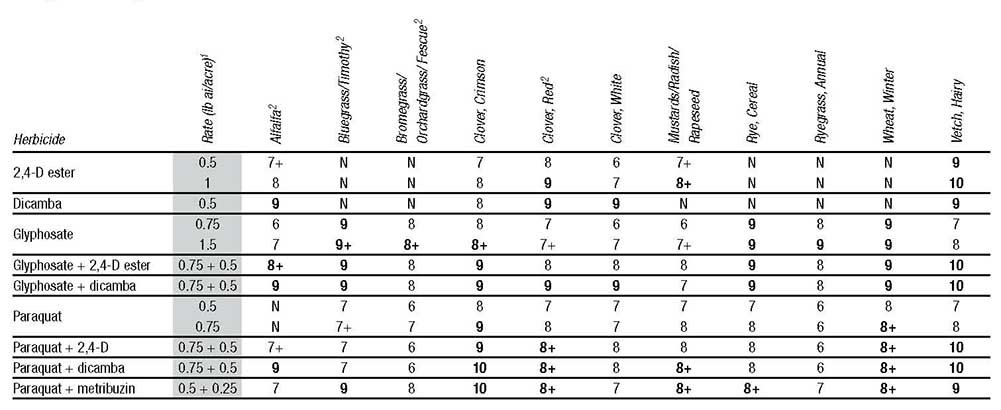Warmer temperatures are promoting cover crop growth and moving up targeted planting dates across the state. Selecting the right herbicide burndown program for cover crop termination will help you start clean this growing season. Here are a few considerations as you get into the field.
Glyphosate is the most effective burndown herbicide for grass cover crops. Actively growing cover crops and sunny warm days (> 55°F) generally increase the activity of glyphosate. Under these conditions, a 0.75 lb ae to 1.5 lb ae rate with appropriate adjuvants (surfactant + AMS) should provide good control of most grass cover crops. A 0.75 lb ae rate is equivalent to 22 fl oz of Roundup or 32 fl oz of Credit, Rascal and other 3 lb ae formulated glyphosate products. Other tips for optimizing glyphosate activity on cover crops include:
- reducing the carrier volume to 10 gal/ac;
- avoiding use of 28 or 32% UAN and and high-rates (> 0.25 lb ai) of clay-based herbicides (WDG, WG, DF, DG, F) like atrazine, simazine and metribuzin.
Paraquat (Gramoxone SL) can be used as an alternative to glyphosate for termination of grass cover crops but is generally less consistent. To optimize control with paraquat, use a high carrier volume (20 gpa) and flat fan nozzle tips to improve coverage. Inclusion of a non-ionic surfactant, a triazine herbicide (atrazine, metribuzin), and UAN as a partial carrier can each improve paraquat activity.
Inclusion of 2,4-D ester or dicamba in burndown programs is likely necessary to achieve adequate control of legume cover crops and can also broaden your weed control spectrum. Both of these herbicides are compatible tank-mix partners with glyphosate and can be used prior to corn or soybean. Apply dicamba or 2,4-D ester 7 to 14 days before planting corn and plant corn at least 1.5 inches deep to enhance crop safety. Be sure to read the herbicide label for pre-plant restrictions prior to soybean for the various 2,4-D and dicamba products now on the market.
Weed Control rating:
10 = 95–100%
9 = 85–95%
8 = 75–85%
7 = 65–75%
6 = 55–65%
N = less than 55%
+ = upper end of rating scale
— = not applicable or no local data available

Table 1: Herbicide recommendations for termination of various cover crop species prior to corn
1 0.75 lb glyphosate = 32 fl oz of a 41% glyphosate; 0.5 lb paraquat = 2 pt Gramoxone SL. Clopyralid is a component of Stinger, and SureStart/TripleFLEX.
2 Application in the fall can improve control with some herbicides.
Cover crop control rating:
10 = 95–100%
9 = 85–95%
8 = 75–85%
7 = 65–75%
6 = 55–65%
N = less than 55% or no control
+ = upper end of rating scale

Table 2: Herbicide recommendations for termination of various cover crop species prior to soybean
1 0.75 lb glyphosate = 32 fl oz of a 41% glyphosate; 0.5 lb paraquat = 2 pt Gramoxone SL; see Table 2.1-8 (glyphosate table) for more information on glyphosate formulations.
2 Application in the fall can improve control with some herbicides.
Here are a few tips for common cover crop species
Winter wheat. Some research suggests that winter wheat is more difficult to control with glyphosate compared to cereal rye. Make sure to use higher glyphosate rates and follow other best management practices described above to optimize herbicide activity in wheat burndown programs. The Roundup Powermax label recommends 32 fl oz up to 18-inch tall wheat. Applications targeting wheat prior to the boot stage are generally more effective.
Annual ryegrass. Annual ryegrass control can be more challenging than winter cereal cover crops. Glyphosate has better activity on annual ryegrass than paraquat (Gramoxone), but several best management practices should be followed, including: 1) timing applications to sunny, warm days (> 55°F); 2) targeting actively growing plants prior to rapid growth stages (< 8-inch); and 3) use of higher glyphosate rates (1.25 to 1.5 lb ae/ac) with appropriate adjuvants.
Legume cover crops. In general, 2,4-D ester or dicamba should be tank mixed with glyphosate or paraquat to improve control of clover species and hairy vetch. A few differences among clover species have been observed in recent field trials conducted at Penn State. Crimson clover is comparatively less susceptible to 2,4-D ester or dicamba applied alone. A tank mix that included glyphosate or paraquat with 2,4-D ester or dicamba products is necessary to achieve adequate crimson clover control, whereas red clover and hairy vetch can be controlled with 2,4-D ester or dicamba applied alone.







Post a comment
Report Abusive Comment